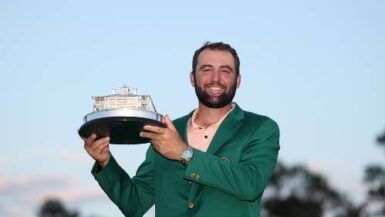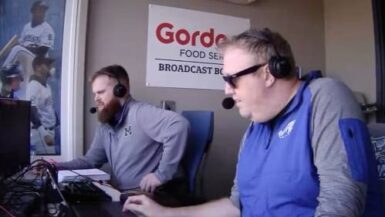You may find yourself
In a beautiful house
With a beautiful wife.
You may ask yourself
“Well, how did I get here?!”
—Talking Heads, “Once in a Lifetime”
The immortal words of David Byrne, that’s what we all might have asked ourselves in April of 1987, even Larry Mize, as he strode out of Butler Cabin clad a Green Jacket, the newly-minted Masters Champion.
He had just pulled the rug out from under everyone in the biggest way.
That Green Jacket was supposed to belong to Greg Norman, or so we thought. Norman was the most-feared player of the era and the hottest golfer alive, a superstar who had won tournaments on every continent except Antarctica. Incredibly, in 1986 he led each of the majors after three rounds, the only golfer ever to accomplish that feat.
He only won one that year though, the Open Championship at Turnberry, and he was left a hard-luck loser in the biggest way at both the Masters and the PGA. It was bad enough that he bogeyed 18 at Augusta with a dopey push-fade-slice to fall out of a tie with Jack Nicklaus. But then he had to watch Bob Tway (of all people) hole a bunker shot in a playoff to steal the Wanamaker Trophy.
Norman had eight long months to relive that nightmare. So when April of 1987 rolled around – finally – Norman was expected to rise like a vengeful phoenix.
No more Mr. Nice Guy. The Shark needs to feed.
And if it wasn’t Norman’s time, then the moment was supposed to belong to Seve Ballesteros, the devastatingly handsome, swashbuckling Spaniard who’d already won two Masters and two Open Championships. Seve also had unfinished business from the 1986 Masters. After a rousing eagle at 13 gave him a 3-shot lead with five holes to play, he fell out of the sky like his parachute didn’t open.
First, Nicklaus charged up the leaderboard, sending Augusta National into orbit. Each cheer was as thunderous as a jet airliner taking off. But then Seve, with a chance to respond, threw up on his shoes instead. He had just belted a 300 yard drive – mind you, with persimmon – and had less that 200 yards, a simple 4-iron, to a green light pin on the par-5 15th. But with the Golden Bear roaring in his ear, Seve hit a ghastly fat-pull-chunk-hook. It fluttering like a football pass that got tipped at the line of scrimmage before diving weakly into Rae’s Creek on one bounce.
My Aunt Bella hits them like that.
At a moment like that, a champion like Seve is like a professional poker player: he can’t stop thinking about the way he lost; it eats at him.
Revenge is powerful motivator. Seve had unfinished business too.
And sure enough, there were Norman and Seve – fighting it out coming down the stretch on the back nine on Sunday, the Green Jacket in the balance. The only trouble was the rest of field was right there with them. Everyone was bunched up, hovering just above or below par. A whopping eight different players held or shared the lead over the back nine on Sunday.
Why you ask? There as a critical change to Augusta National that year that was later reversed. If you watch video of the ’87 Masters you notice something that wasn’t there in 1986, nor is it their now: a grotesque swath of rough lining every fairway. It acted as a restrictor plate, making the tournament more like a U.S. Open in April, and it bunched up the scores. When Nicklaus won in 1986 he dd it with a 9-under 279. In 1987 3-under 285 got you into the first 3-way, sudden victory playoff in Masters history. Further, Nicklaus closed the ’86 tournament with that epic 65, including a 30 on the back nine. In 1987 nobody in the top ten broke 70 on Sunday except Jodie Mudd, and that was with a 69.
“When you grow the rough like that, and make it ridiculously tough, you let all the riff-raff on to the leaderboard,” groused one golf writer.
It was 17 and 18 that finally cleared the logjam. First, Mize broke free of the pack with a textbook-perfect birdie on 18: 3-wood to the center of the fairway + 6-iron to eight feet + dead center on the putt = leader in the clubhouse!
As an aside, that was a second change made to Augusta in 1987 that is still in existence today: the front left hole location for a Sunday pin on 18. You’ll recall that in ’86 Nicklaus had to play to a back right pin and left his approach short enough that he had 40 feet uphill.
“Oh great!” he said to himself. “Now I have THIS putt…”
But in ’87 Mize played to the hole location you see today – front left. His birdie gave him a sole share of the lead, but minutes later both Seve and Norman birdied 17 to also reach 3-under.
So the playoff looked to all the world like our generation’s greatest prize fight: Seve vs. Norman, two matinee idols battling it out mano-a-mano, pistols at sunset for the Green Jacket! Between the two of them they’d already captured four majors and 72 events world-wide. Could we ask for a better script?
And in between? Poor Larry Mize, trapped between an immovable object and an irresistible force. A man who’d won exactly one time in seven years on the PGA Tour – the 1983 Memphis Classic. In his only prior playoff appearance he lost to Norman at the 1986 Kemper Open. He was, as the great Peter Alliss called him during the broadcast, “The Outsider,” the unexpected upstart, an officious intermeddler expected to dutifully get off the stage at the first opportunity.
Director! We have script revisions for Act V!
On the first extra hole, Seve got careless with a downhill twisting putt and left himself five feet coming back, a distance at which he’s normally automatic, but this is Augusta. He flat-out pulled it.
It was a long, lonely walk he took back to the clubhouse after that.
Meanwhile Mize, an Augusta native, a Georgia Tech grad, and the local favorite had a chance to win the tournament with a 15-footer of his own but, excruciatingly, he left it just short. It seemed like Mize was destined to play the bridesmaid’s role once again. You can’t give a world-class golfer like Norman a second chance, can you?
Yes, actually, it’s Greg Norman we’re talking about here. The Golf Gods like using him as a punching bag.
Ironically, the only reason the stage was set for Mize’s miraculaous pitch-in to win, was because the shot that preceded it was so horrendous. From the middle of the 11th fairway with a mid-iron in his hands, Mize hit a goofy slice that missed the green by 45 yards: short and right, the ugliest shot in golf.
“Your mind is saying ‘Don’t hit it in the water.’ I just bailed out,” he explained. “”I knew if I hit it left, it was pretty much over, so I blocked it right.”
“Oh my gosh!” he groaned agonizingly as his wounded duck bounded among the closely mowed chipping area and settled 140 feet form the cup, leaving him a delicate pitch up the hill with the water beckoning behind the pin if he hit it too hard.
“I didn’t think he’d get down in two from there, and he didn’t,” groused Norman afterwards. “He got down in one.”
As Mize’s pitch tumbled into the cup, the Georgia locals danced joyfully, while poor Norman was left to ponder lightning striking twice in the same place.
“”I’ve holed 10-, 15-, 20-foot putts to win, but not bunker shots or chip shots from 140 feet,” he stated. “I couldn’t believe it. I saw the ball rolling in and thought, Well, if it misses it’ll probably go four or five feet by. I was just watching for the speed of the green, and I watched, and then the closer it got to the hole the more it looked like it was going in, and then—oh my God…..This is probably the toughest loss I’ve ever had. The PGA was tough, but this one…because of the shot…I think I’m more disappointed now than in any tournament I’ve played.”
Meanwhile Mize, the kid who grew up peering through the gates of Augusta National and worked the third hole scoreboard during the tournament when he was 14 became an honorary member with, at that time, a lifetime exemption to play in the tournament. For his second professional win, he sure picked a good time.
“I never played Augusta National growing up because I wanted to earn my way on to the course,” he said. He did it, all right, with a shot that golf will never forget. When kids dream about the Masters, it’s shots like Mize’s that come to mind. So work hard, kids. Sometimes those dreams come true.






